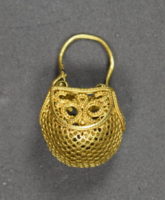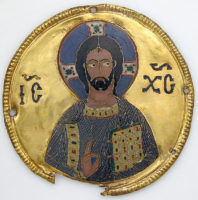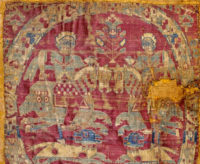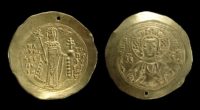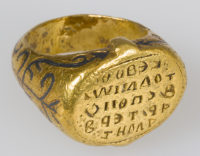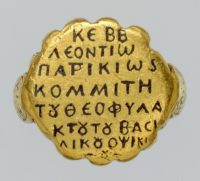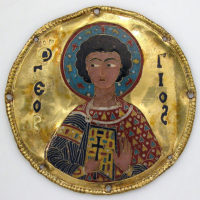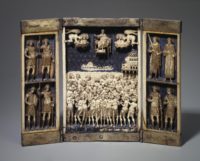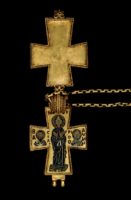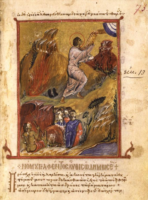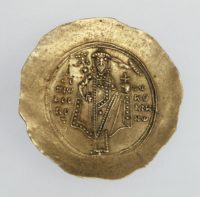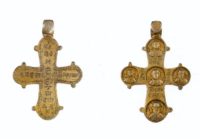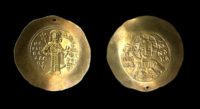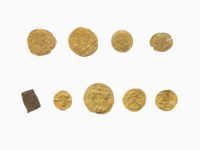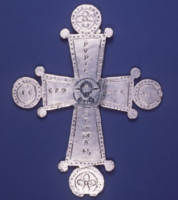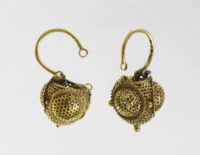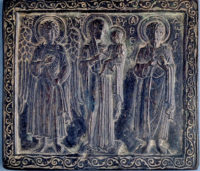Earring; Period: Middle Byzantine circa: 10thC-12thC. Materials: gold. British Museum is closed 24, 25 and 26 December and 1 January, but is open every other day of the year. Fast facts about the British Museum: Founded: 1753, Collection size: 8 million objects, Oldest object in the collection: Stone chopping tool (nearly 2 million years old).
This medallion of Christ is from a group of twelve that once surrounded an icon of the archangel Gabriel. Period: Middle Byzantine, circa: ca. 1100, Made in Constantinople, Materials: Gold, silver, and enamel worked in cloisonné. The Metropolitan Museum of Art (New York) is one of the world’s largest and finest art museums. Its collection includes more than two million works of art spanning five thousand years of world culture, from prehistory to the present and from every part of the globe. Public Hours: 10:30 a.m.–5:30 p.m. Open seven days a week.
Textile Fragment, Materials: silk and cotton. Period: Middle Byzantine, circa: 8thc-9thc. Rectangular panel of woven silk sen onto a larger cotton cloth of irregular, roughly rectangular shape; two hunters on horseback, in a round frame with floral ornament. British Museum is closed 24, 25 and 26 December and 1 January, but is open every other day of the year.
Gold coin; Ruler: Manuel I Comnenus, Byzantine emperor; circa: 1143-1180; Minted in: Constantinople. Weight: 4.484 grammes. British Museum is closed 24, 25 and 26 December and 1 January, but is open every other day of the year. Fast facts about the British Museum: Founded: 1753, Collection size: 8 million objects, Oldest object in the collection: Stone chopping tool (nearly 2 million years old).
Signet Ring of John, Imperial Spatharios, Period: Middle Byzantine, circa: 10th century, Materials: Gold, niello. On view at The Met Fifth Avenue in Gallery 300 . Museum Description: “The title spatharios, Sword-Bearer, was originally an honor reserved for the imperial bodyguard. By the middle Byzantine period, it had become an honorific title only, indicating Ioannis’s respectable status.” The Metropolitan Museum of Art (New York) is one of the world’s largest and finest art museums. Its collection includes more than two million works of art spanning five thousand years of world culture, from prehistory to the present and from every part of the globe. Public Hours: 10:30 a.m.–5:30 p.m. Open seven days a week.
Ring of Leontios, Period: Middle Byzantine, circa: 1000, Materials: Gold, niello, Inscribed: “Lord help Leontius, Patrician and Count of imperial Obsikion guarded by God”. The ring came from Leontios of the district of Opsikion, in exactly what is currently northwestern Turkey. Patrikios as well as komes were Roman titles that moved in definition throughout the Byzantine period; it promises that Leontios was the guv of the district or an upper-level general. On view at The Met Fifth Avenue in Gallery 303 . The Metropolitan Museum of Art (New York) is one of the world’s largest and finest art museums. Its collection includes more than two million works of art spanning five thousand years of world culture, from prehistory to the present and from every part of the globe. Public Hours: 10:30 a.m.–5:30 p.m. Open seven days a week.
Medallion with Saint George from an Icon Frame, Period: Middle Byzantine, circa: 1100, Made in Constantinople, Materials: Gold, silver, and enamel worked in cloisonné. On view at The Met Fifth Avenue in Gallery 303. The Metropolitan Museum of Art (New York) is one of the world’s largest and finest art museums. Its collection includes more than two million works of art spanning five thousand years of world culture, from prehistory to the present and from every part of the globe. Public Hours: 10:30 a.m.–5:30 p.m. Open seven days a week.
Crescent-Shaped Pendant, Period: Middle Byzantine; circa: 11th century. Materials: gold filigree with cloisonné enamel. Dimensions: 3 x 3.2 cm (1 3/16 x 1 1/4 in.). The Cleveland Art Museum Hours: Tuesdays, Thursdays, Saturdays, Sundays 10:00 a.m.–5:00 p.m. Wednesdays, Fridays 10:00 a.m.–9:00 p.m. Closed Mondays.
Pendant Icon with the Virgin “Dexiokratousa” and Frame with Winged Bull of Saint Luke on the back, Pendant 1100s; Frame mid. Period: Middle Byzantine. Materials: Steatite, Gilt silver, Pearls. The Cleveland Art Museum Hours: Tuesdays, Thursdays, Saturdays, Sundays 10:00 a.m.–5:00 p.m. Wednesdays, Fridays 10:00 a.m.–9:00 p.m. Closed Mondays.
Triptych Showing the Forty Martyrs, Period: Middle Byzantine; circa: Late 11th – early 12th century. Materials: ivory and silver (frame). Technique: carved and painted. Dimensions: 18,5×24,2 cm. The collection of the State Hermitage includes over 3 million works of art and world culture artefacts. It contains paintings, graphic works, sculptures, works of applied art, archaeological artefacts and numismatic objects. The Hermitage is considered to have been founded in 1764, when Empress Catherine the Great acquired an impressive collection of works from the Berlin merchant Johann Ernst Gotzkowsky. The museum celebrates the anniversary of its founding each year on 7 December, St. Catherine’s Day. Opening Hours: Tuesday, Thursday, Saturday, Sunday: 10.30-18.00 Wednesday, Friday: 10.30-21.00 Closed: Monday.
Reliquary Cross; Materials: Cloisonné Enamel and Gold, Period: Middle Byzantine (10thc.) Made in: Constantinople. Museum Description: “Decorated with a standing figure of the Virgin, wearing chiton and maphorion, flanked by busts of St Basil and St Gregory Thaumaturgus; cylindrical gold chain connected to pendant; part of chain in another style.” British Museum is closed 24, 25 and 26 December and 1 January, but is open every other day of the year. Fast facts about the British Museum: Founded: 1753, Collection size: 8 million objects, Oldest object in the collection: Stone chopping tool (nearly 2 million years old).
Psalter and New Testament, Period: Middle Byzantine, circa. 1084 A.D. The museum is open to the public Tuesday through Sunday, 11:30 a.m.–5:30 p.m., except for federal holidays.
Hyperpyron, Ruler: Alexius I, Period: Middle Byzantine; circa: Between 1092 and 1118. Material: gold. Technique: chased. The collection of the State Hermitage includes over 3 million works of art and world culture artefacts. It contains paintings, graphic works, sculptures, works of applied art, archaeological artefacts and numismatic objects. The Hermitage is considered to have been founded in 1764, when Empress Catherine the Great acquired an impressive collection of works from the Berlin merchant Johann Ernst Gotzkowsky. The museum celebrates the anniversary of its founding each year on 7 December, St. Catherine’s Day. Opening Hours: Tuesday, Thursday, Saturday, Sunday: 10.30-18.00 Wednesday, Friday: 10.30-21.00 Closed: Monday.
Pectoral cross with busts of Jesus Christ and saints, silver-gilt. On the reverse, the engraved inscription refers to its owner: Epiphanios. Period: Middle Byzantine; circa: 11th c. The Benaki Museum of Greek Culture is housed in one of the most beautiful neoclassical-style buildings in Athens, near the National Garden and the Hellenic Parliament.
Gold coin; Ruler: Manuel I Comnenus, Byzantine emperor; Period: Middle Byzantine; circa: 1143-1180; Minted in Constantinople. British Museum is closed 24, 25 and 26 December and 1 January, but is open every other day of the year. Fast facts about the British Museum: Founded: 1753, Collection size: 8 million objects, Oldest object in the collection: Stone chopping tool (nearly 2 million years old).
Gold coin, Ruler: Tiberius III, 705-711, Minted in: Ravenna, Weight: 4.238 grammes. British Museum is closed 24, 25 and 26 December and 1 January, but is open every other day of the year. Fast facts about the British Museum: Founded: 1753, Collection size: 8 million objects, Oldest object in the collection: Stone chopping tool (nearly 2 million years old).
Coin, Ruler: Tiberius III, Byzantine Emperor; circa: 705-711; Minted in: Ravenna. Weight: 4.309 grammes. British Museum is closed 24, 25 and 26 December and 1 January, but is open every other day of the year. Fast facts about the British Museum: Founded: 1753, Collection size: 8 million objects, Oldest object in the collection: Stone chopping tool (nearly 2 million years old).
Cross of Romanos II and Basil II, Period: Middle Byzantine, Date: 960-963. Materials: silver and niello. Purchased by Mildred and Robert Woods Bliss from George Zacos (dealer) Istanbul, July 24th, 1953; Gift of Milderd and Robert Woods Bliss to Dumbarton Oaks Research Library and Collection, Washington, DC, 1953; The museum is open to the public Tuesday through Sunday, 11:30 a.m.–5:30 p.m., except for federal holidays.
Earring, Period: Middle Byzantine circa: 11thc. Height: 1 inches. Material: gold. British Museum is closed 24, 25 and 26 December and 1 January, but is open every other day of the year. Fast facts about the British Museum: Founded: 1753, Collection size: 8 million objects, Oldest object in the collection: Stone chopping tool (nearly 2 million years old).
Relief icon; rectangular bronze plaque cast in low relief with full-length Hodegetria flanked by the Archangel Michael and St Theodore, each wearing a girdled tunic beneath a chlamys with decorated tablion; the figures are identified by intaglio inscriptions; the whole is surrounded by a raised border with a running vine scroll; traces of solder at sides and back. Period: Middle Byzantine. British Museum is closed 24, 25 and 26 December and 1 January, but is open every other day of the year. Fast facts about the British Museum: Founded: 1753, Collection size: 8 million objects, Oldest object in the collection: Stone chopping tool (nearly 2 million years old).


